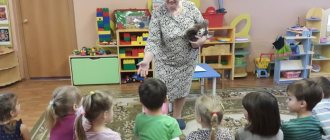Project “Project of musical and theatrical activities “The Magic World of Theater” in senior group No. 2”
LIST OF DIDACTIC MATERIALS (LITERATURE) FOR SOLVING THE TASKS AND GOALS OF THE PROJECT
1. “Musical palette” No. 6 2005
2. “Musical Director” No. 6, 7, 8 2008; No. 1 2009
3. S. I. Merzlyakova “The Magic World of Theater” (for children 5-7 years old).
4. A. I. Burenina “Rhythmic mosaic”.
5. N. A. Sorokina “Theatre, creativity, children”
6. “Puppet theater for preschoolers” T. N. Karamanenko, Yu. G. Karamanenko
CONSULTATION FOR TEACHERS
THEATER GAMES
THE PATH TO CHILDREN'S CREATIVITY.
A developing environment that promotes self-expression in the process of artistic activity is of great importance for the development of a child’s personality.
A person who is equally developed both emotionally and intellectually can be called truly integral. We must strive to develop both in a child. Unfortunately, most often, emotional education is neglected, giving preference to the development of intellectual capabilities.
“The danger is not that machines will start thinking. Like a person, but the fact is that a person will begin to think like a machine!” – Professor G. Suvorov.
“Harmony of mind and heart is the ultimate goal of educating a modern person” - D. B. Kabalevsky.
A child who gets used to expressing his emotions through various types of artistic activities begins to view his “I” in a new way, his own behavior and the behavior of others, his relationships with people, as well as nature and the world around him. Raising a whole personality is not an easy task. This requires conditions: the presence of a teacher and the presence of an environment that evokes a positive emotional response from the child. Hence the need arises for forms of classes in which each child will actively experience the content of the lesson and actively participate in artistic self-expression. A preschooler should not just sit in class and obediently complete tasks. The joy of creativity, an active relationship with an adult, takes the child from a position of passive acquisition of knowledge, skills and abilities to a position of creative activity, initiative, and independence. Only this can develop creativity in every child.
With all the variety of types of artistic activity, theatrical games occupy a special place in the educational process. They are designed for children's activity, for their creative interaction with each other, for artistic and active communication with adults. Through theatrical play, the child receives information about the world around him, and his creative abilities are formed. With the help of such expressive means as intonation, facial expressions, gestures, gait, literary works, fairy-tale plots, and comic dialogues are acted out.
Card index of musical and didactic games for senior and preparatory groups
MBDOU No. 66 “Barvinok”, Simferopol
Card index of musical and didactic games for senior and preparatory groups
musical director
specialist of the first category
Simferopol, 2016
Steps.
Didactic games for determining the pitch of sounds.
Goal: to develop children’s pitch hearing.
Playing material: a ladder of five steps, toys (matryoshka, bear, bunny), children's musical instruments (accordion, metallophone, harmonica).
Progress of the game: The leading child plays a melody on any instrument, another child determines the movement of the melody up, down or on one sound and accordingly moves a toy (for example, a bunny) up the steps of the ladder up, down or taps on one step. The next child uses a different toy.
Find the right bell.
Didactic games for determining the pitch of sounds.
Goal: to develop children’s pitch hearing.
Game material. Five sets of Valdai type bells.
Progress of the game: Five children participate in the game, one of them is the leader. He sits behind a small screen or with his back to the players and rings one bell or another. Children must find a bell in their set that matches this sound and ring it. When the game is repeated, the leader becomes the one who correctly identified the sound of each bell.
Determine by rhythm.
Didactic games for the development of rhythmic hearing.
Goal: to develop children's sense of rhythm.
Game material. Cards, on one half of which a rhythmic pattern of a song familiar to children is depicted, the other half is empty; pictures illustrating the content of the song; children's musical instruments - a group of percussion (spoons, square, drum, musical hammer, etc.). Each person is given 2-3 cards.
Progress of the game: The child leader performs a rhythmic pattern of a familiar song on one of the instruments. Children determine the song by rhythm and cover the empty half of the card with a picture (the presenter gives the picture after the correct answer).
When the game is repeated, the leader becomes the one who has never made a mistake. One child can be given a larger number of cards (3-4).
Cheerful girlfriends.
Didactic games for the development of rhythmic hearing.
Goal: to develop children's sense of rhythm.
Game material: flat cardboard figures (5 pcs.). You can use options: all dolls are the same size, but painted differently, or dolls of different sizes (like nesting dolls) wearing clothes with different patterns, etc.
Progress of the game: the figures stand on the table, one after the other in a column. Children sit in a semicircle or in a checkerboard pattern, facing the table. The Russian folk melody “The Moon is Shining” sounds.
Teacher: Guys, meet our cheerful friends who came to visit us: Dashenka, Glashenka, Sashenka, Irinushka, Marinushka. (Puts them out in one line.) They love to dance and want to teach you. This is how Dashenka can do it!
The teacher takes a matryoshka doll and taps a rhythmic pattern with a wooden stand. Children repeat the rhythm on wooden spoons. You can simply clap the rhythm with your hands. Rhythms can also be demonstrated to children by performing them on the piano.
What do I play on?
Didactic games for the development of timbre hearing.
Purpose of the game: to develop children's sense of timbre. Game material: cards (according to the number of players), on one half of which there is an image of children's musical instruments, the other half is empty; chips and children's musical instruments.
Progress of the game: children are given several cards (3-4). The child leader plays a melody or rhythmic pattern on some instrument (there is a small screen in front of the leader). Children determine the sound of the instrument and cover the second half of the card with a chip. The game can be played like a lotto. On one large card, divided into 4-6 squares, an image of various tools is given (4-6). There should be more small cards depicting the same tools and equal to the number of large cards. Each child is given one large card and 4-6 small ones. The game is played in the same way, but only the children cover the corresponding image on the large one with a small card.
Musical riddles.
Didactic games for the development of timbre hearing.
Purpose of the game: to develop children's sense of timbre.
Playing material: metallophone, triangle, bells, tambourine, harp, cymbals.
Progress of the game: children sit in a semicircle in front of a screen, behind which there is a table. there are musical instruments and toys. The child leader plays a melody or rhythmic pattern on an instrument. Children guess. For the correct answer, the child receives a chip. The one with the most chips wins.
We'll start drinking loudly and quietly.
Didactic games for the development of diatonic hearing.
Goal: to develop diatonic hearing in children.
Game material: any toy.
Progress of the game: children choose a driver. He leaves the room. Everyone agrees on where to hide the toy. The driver must find it, guided by the volume of the song that all the children sing: the sound intensifies as it approaches the place where the toy is located, or weakens as it moves away from it. If the child successfully completed the task, when the game is repeated, he has the right to hide the toy.
Kolobok.
Didactic games for the development of diatonic hearing.
Goal: to develop diatonic hearing in children.
Game material: playing field, hammer, bun and several different small objects depicting a haystack, log, stump, anthill, Christmas tree. All this is placed on the playing field in any order.
Progress of the game: children look at the figures on the playing field, then choose a driver, he goes out the door or turns away from the rest of the players. The children agree on which figure they will hide the bun behind, and call the driver:
“The bun has rolled away, the bun has a ruddy side,
How can we find him and bring him to grandma and grandpa?
Come on, Ira, walk along the path, walk
And use the funny song to find the bun.”
Everyone sings any familiar song. The driver takes a hammer and moves it along the paths from figure to figure. If the hammer is far from the figure behind which the bun is hidden, then the children sing quietly, if close, they sing loudly.
Song, dance, march.
Didactic game to determine the genre.
Purpose of the game:
1. Give an idea of the primary genres of music
(song, dance, march), their characteristic features.
2. Introduce arrangements of folk melodies - piano, orchestral.
3. Enrich children’s statements about the emotional and figurative content of music.
4. Give an idea that a piece of music can have characteristics of two genres at the same time.
Progress of the game:
Option 1 The music director performs (or lets the children listen to) a piece of music (or excerpt). Invites two children. The first child chooses a card that matches the genre of this piece of music. The called child takes the card and shows it. If the work is known to children, then its title and the name of the composer are said. The second child shows a card that depicts the character of a piece of music that corresponds to the character of the music (this could be a “smiley”, “face” - sleeping, crying, cheerful).
Option 2. Each child has a card in front of them. The music director performs the piece, and children whose cards match either the genre or character of the piece of music raise them.
Let's listen to music.
Didactic game for the development of musical memory.
Goal: to develop musical memory, to enrich children’s statements about the emotional and figurative content of music.
Game material: 4-5 pictures illustrating the content of musical works familiar to children (these can also be instrumental pieces).
Progress of the game: children sit in a semicircle, pictures are placed on the table in front of them so that they are clearly visible to everyone playing. Play a piece of music. The called child must find the corresponding picture, name the work and the composer who wrote this music. If the answer is correct, everyone claps.
What music?
Didactic game to develop music perception.
Goal: to develop the ability to listen to music, to enrich children’s statements about the emotional and figurative content of music.
Playing material: record player, records with recordings of waltz, dance, polka; cards with images of waltz, folk dance and polka dancers.
Progress of the game: children are given cards. The music director performs musical pieces on the piano (recorded) that correspond to the content of the pictures on the cards. Children recognize the work and pick up the correct card.
Get text


